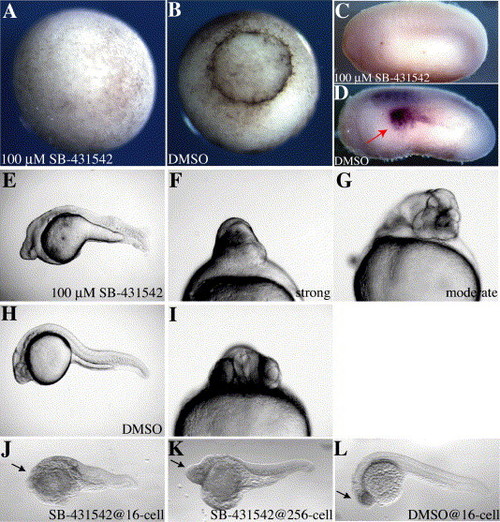Fig. 2
|
SB-431542 induces morphological defects in embryos. (A–B) Xenopus embryos were treated with SB-431542 (A) or DMSO (B) at stage 3 and allowed to develop until stage 11. Note failure of blastopore lip formation in the treated embryo. (C–D) Xenopus embryos were treated with SB-431542 (C) or DMSO (D) at stage 13 and fixed for in situ hybridization with an xAntivin antisense probe at stage 22. Embryos are photographed with anterior to the left and the left side showing. Note loss of left-sided xAntivin expression (red arrow in panel D) in the treated embryo. (E–I) Zebrafish embryos were treated with 100 μM SB-431542 or DMSO at 16-cell stage and examined at 24 hpf. (E) SB-431542-treated embryo, displaying head and midline defects, fewer and more posterior somites, and poor yolk extension morphology. (F) Close-up of head region of SB-431542-treated embryo with “severe” phenotype. (G) Close-up of head region of SB-431542-treated embryo with “moderate” phenotype. (H) DMSO-treated control embryo. (I) Close-up of head region of control embryo. (J–L) Embryos treated at 16-cell (J) have more severe loss of head and axial structures (arrows) than those treated at 256-cell (K), although both are significantly perturbed compared to controls (L). |
Reprinted from Developmental Biology, 295(2), Ho, D.M., Chan, J., Bayliss, P., and Whitman, M., Inhibitor-resistant type I receptors reveal specific requirements for TGF-beta signaling in vivo, 730-742, Copyright (2006) with permission from Elsevier. Full text @ Dev. Biol.

